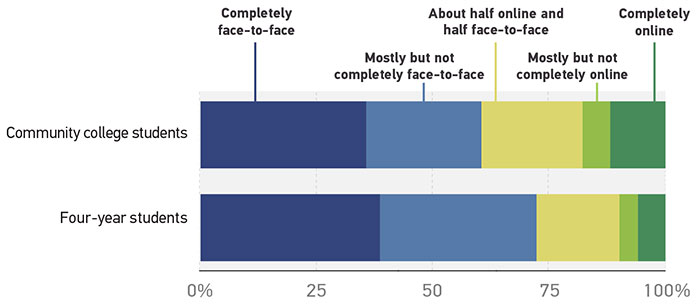Learning Environment Preferences
Since a larger proportion of community college students work full time, live on their own, and have family responsibilities, it's no surprise that more (69%) say they have taken online courses in the past 12 months than students at four-year institutions (54%). Around half of all students in both groups favor blended courses; however, two-year and AA students are also twice as likely to prefer environments that are completely online (12%, versus 6% of non–community college students) (figure 5). We also found some differences when we controlled for a few key demographic factors among the community college group. Women, students who work, people who are married or in a domestic partnership, and students who have dependents are all more likely to prefer learning environments that are mostly or completely online.

Our analysis from the 2018 student study revealed that the most significant predictor of learning environment preference was the respondent's most recent experience,1 and this seems to hold true for community college students as well. It stands to reason that they would gravitate toward environments that are both familiar and recent. However, other factors are at play in the lives of community college students. The higher preference for courses that are mostly or completely online may be pragmatic or a matter of necessity to help them balance the demands of work, family, and education. For example, research on community college students' choices between online and face-to-face courses indicates that work schedules (e.g., long hours and overnight and/or irregular shifts), childcare responsibilities, and transportation issues (long distances to campus, not owning a car, and the expense of fuel) were circumstances that influenced their selection.2
Some research has indicated that community college students do not perform as well in online-only courses;3 however, other studies have revealed a paradox: that while students may not perform as well at the course level, those who took some of their courses online were more likely to complete an associate's degree or credential or transfer to a four-year institution.4 Research on hybrid courses has shown that community college students do just as well in blended environments as they do in face-to-face courses.5 With these data in mind, offering more blended and online courses might help community college students stay on the path toward finishing their degrees or programs as they juggle the time it takes to study, work, and care for their families. But offering additional courses of these types should be coupled with student support. As noted in the 2018 undergraduate study, informing students about the benefits, expectations, and demands of blended and online courses gives them the tools to make decisions about the learning environments that best suit their needs. For example, research on mandatory orientations for community college students enrolled in online courses has shown that increased success rates and lower withdrawal rates result.6 Implementing early-alert systems and promoting their use among faculty who teach online and blended courses also offers community colleges a way to track students who are struggling academically, allowing for earlier interventions.
Notes
-
Joseph D. Galanek, Dana C. Gierdowski, and D. Christopher Brooks, ECAR Study of Undergraduate Students and Information Technology, 2018, research report (Louisville, CO: ECAR, October 2018).
↩︎ -
Shanna Smith Jaggars, "Choosing Between Online and Face-to-Face Courses: Community College Student Voices," American Journal of Distance Education 28, no. 1 (2014): 27–38.
↩︎ -
Shanna Smith Jaggars and Di Xu, "Online Learning in the Virginia Community College System," Community College Research Center, September 2010; Di Xu and Shanna Smith Jaggars, "Adaptability to Online Learning: Differences across Types of Students and Academic Subject Areas," Working Paper No. 54, Community College Research Center, February 2013.
↩︎ -
Hans Johnson and Marisol Cuellar Mejia, "Online Learning and Student Outcomes in California's Community Colleges," Public Policy Institute of California, May 2014; Peter Shea and Temi Bidjerano, "Does Online Learning Impede Degree Completion? A National Study of Community College Students," Computers & Education 75 (2014): 103–111.
↩︎ -
Corinne Crawford, Joel Barker, and Achraf Seyam, "The Promising Role of Hybrid Learning in Community Colleges: Looking towards the Future," Contemporary Issues in Education Research 7, no. 3 (3rd quarter, 2014).
↩︎ -
See "Bay College (MI)" at "Eleven Colleges Recognized as Leader Colleges of Distinction," Achieving the Dream; "Success Online: Be a Successful Online Learner," Bay College.
↩︎